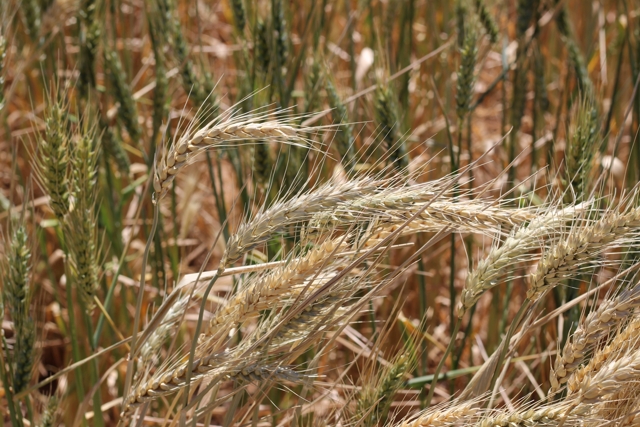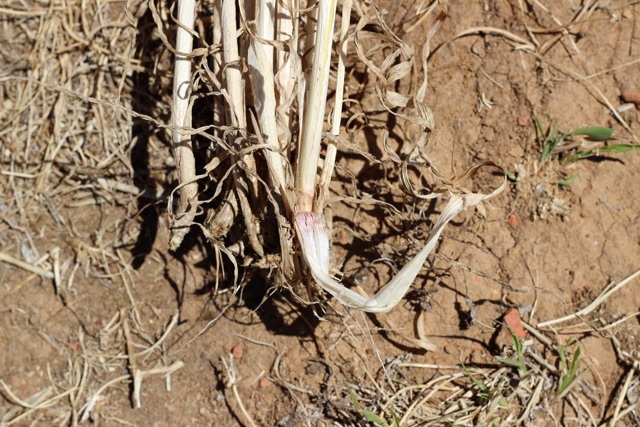Prepare for greater winter cereal disease pressure
 PRODUCTION ADVICE - APRIL 2020 - AGRONOMY
PRODUCTION ADVICE - APRIL 2020 - AGRONOMY
By John Fowler
Extension Agronomist
P: 03 5881 9933 | M: 0427 079 138 | john.fowler@lls.nsw.gov.au
While the focus of the world is currently on human diseases, winter cereal growers need to be preparing now for increased crop disease pressure this coming season. It is likely that diseases such as crown rot, Rhizoctonia root rot and yellow leaf spot on wheat, and spot form net blotch on barley, will be widespread.
The reason for the increased risk is the dry conditions of the past two years. These diseases are carried over on stubbles, which have been very slow to break down under the dry conditions. The fungal spores are still present and will readily infect crops this season.
For wheat growers in the western half of the Murray Local Land Services region, crown rot is probably the main concern.
Crown rot
 Crown rot (see photo, right) is often the main crown/root disease of wheat in the Deniliquin district. It usually requires a two-year break from cereals to adequately control it, but even longer breaks may be required at present. Growers sowing wheat into country that has grown wheat or barley in the last three years need to be aware of the increased risk they face (and if they have grown durum wheats, there is an even greater risk of disease carry over).
Crown rot (see photo, right) is often the main crown/root disease of wheat in the Deniliquin district. It usually requires a two-year break from cereals to adequately control it, but even longer breaks may be required at present. Growers sowing wheat into country that has grown wheat or barley in the last three years need to be aware of the increased risk they face (and if they have grown durum wheats, there is an even greater risk of disease carry over).
Steven Simpfendorfer, a plant pathologist with NSW DPI, presented a paper to advisers on preparing for the disease risk at the recent GRDC Advisers Update in Wagga Wagga. He indicated that a survey of 11 paddocks in south-western NSW last year showed that 64 per cent of paddocks had a high level of Fusarium spp (the fungus causing crown rot), and 18 per cent had medium levels. He reminded growers that spores will carry over on any undecomposed stubble from 2017, 2018 or 2019. He proposed four steps for growers to take.
Step 1: Know before you sow
Growers need to be aware in advance of the risk they face. This can be achieved by undertaking a Predicta B disease test. This will give an indication of whether the disease pressure is low, medium or high. It is important that the agronomist taking the test uses the recommended protocol and latest risk categories.
Step 2: Pre-sowing options
There are pre-sowing options for paddocks where the disease pressure is shown to be either medium or high. They include:
- Sow more tolerant wheat or barley varieties. The NSW DPI ‘Winter crop variety sowing guide’ (available on their website) indicates relative varietal tolerances to crown rot.
- Sow at the start of the recommended window. This is always a good idea in areas west of Finley, as the hot dry finish we experience causes more yield loss in most seasons than frost. The added disease pressure is another reason to adhere to this guideline if possible. (Growers in more frost-prone areas in the east need to avoid sowing earlier than the recommended window for their varieties.)
- If possible, inter-row sow. This reduces proximity to the spores on previous stubble. Steven Simpfendorfer indicated that cultivation is not recommended.
- Be conservative with nitrogen (N) application at sowing. While a starter fertiliser with moderate amounts of N is OK, avoid higher application of N at sowing. Rely more on top-dressing nitrogen later in the season.
- Remember, current seed treatments give suppression only, so do not rely on them alone to manage crown rot.
Step 3: Sow quality seed
Seed not only needs to have good germination but also good vigour.
Seed vigour is closely linked to seed size. If possible, seed should be heavily graded to remove all small grains. Larger seeds will have greater vigour, which is important to get the crop away before the onset of disease pressure.
Some fungicides will also reduce seed vigour, so be sure to talk with your agronomist about what is safe to use.
Step 4: Assess infection levels at head emergence
 Crown rot infections are more noticeable later in the season. Head emergence is a good time to walk through crops to determine the level of infection. This step is encouraged so that informed decisions can be made for following seasons.
Crown rot infections are more noticeable later in the season. Head emergence is a good time to walk through crops to determine the level of infection. This step is encouraged so that informed decisions can be made for following seasons.
The first indication of crown rot will be white heads throughout the crop. Examine the base of these plants - if it a dark honey brown in colour, it is crown rot. In most, but not all, cases there will also be a pink colouration caused by the fungal spores (see photo, right).
Free Testing: NSW DPI is offering free sample testing for crown rot for wheat and barley being sown into stubble paddocks. Collect 60 dry, intact main tillers per paddock (separate years) and send to:
Cereal Stubble Testing
Steven Simpfendorfer
NSW DPI, 4Marsden Park Rd
Tamworth NSW 2340